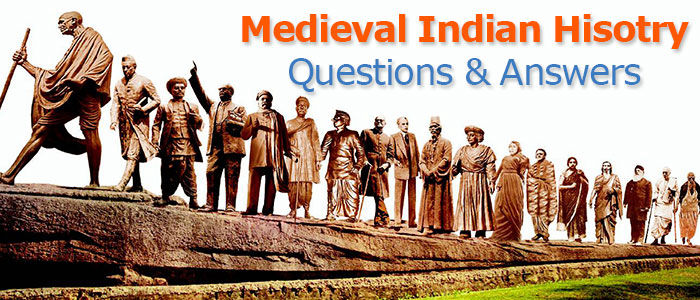Medieval Indian History Objective Questions for Competitive Exams

At a place called Lothal, artificial dockyard was from which civilization-
(A) Indus Valley
(B) Mesopatamian
(C) Egyption
(D) Persian
Correct Answer : A
Explanation :
Artificial Dockyard of Indus Valley civilization was at Lothal.
What was the strength of Indus economy-
(A) Agriculture
(B) Business
(C) Pattery
(D) Crockery
Correct Answer : A
Explanation :
The economic base of Indus civilization was agriculture and animal husbandary cotton was first cultivated by the people of Indus civilization. In addition, they used to produce wheat, barley and rice, The Evidences of cow, ox, buffalo, camel, sheep, goot, pig, and dog etc. are found there. But Indus people didn’t know about horses. These people were expert in business and craft Industry.
Which of the following has not been found in the excavation in Terracotta of Indus Valley sites?
(A) Buffalo
(B) Sheep
(C) Cow
(D) Pig
Correct Answer : C
Explanation :
There is no evidences of cow in terracotta in Indus civilization
Ghiyasuddin Balban (1265-1286 AD), ruler of the Slave dynasty, took up the title of ____________.
(A) Nur-al-Din (light of the faith)
(B) NurMahal (light of the palace)
(C) Zil-i-Ilahi (shadow of God)
(D) JahanPanah (protector of the world)
Correct Answer : C
Explanation :
He declared the sultan as representative of God on Earth. Persian court model influenced Balban's conception of kingship. He took up the title of Zil-i-Ilahi (a shadow of God) and impressed upon the people that the king was the deputy of God (Niyabat-i-Khudai).
When did the Harappan civilization flourish?
(A) 2500 to 1500 BCE
(B) 500 BCE to 500 CE
(C) 1000 to 500 BCE
(D) 2000 to 1000 BCE
Correct Answer : A
Explanation :
The Harappan civilization, also known as the Indus Valley civilization, flourished around 3300 to 1300 BCE. It was one of the world's earliest urban civilizations, and its remains have been discovered in the modern-day countries of India and Pakistan, as well as Afghanistan and Iran. The civilization was named after the ancient city of Harappa, one of its major centers.
What were the major cities of the Harappan civilization?
(A) Mohenjo-Daro, Athens, Rome, Beijing
(B) Harappa, Mohenjo-Daro, Lothal, Dholavira
(C) Babylon, Memphis, Thebes, Ur
(D) Petra, Carthage, Ephesus, Nineveh
Correct Answer : B
Explanation :
The Harappan civilization was characterized by its well-planned cities and advanced infrastructure. Some of the major cities of the Harappan civilization include:
1. Harappa: Harappa was one of the first cities to be excavated in the 1920s and gave its name to the entire civilization. It is located in present-day Pakistan and was a significant center of the ancient Indus Valley civilization.
2. Mohenjo-Daro: Mohenjo-Daro, meaning "Mound of the Dead," is another major city of the Harappan civilization, located in present-day Pakistan. It was one of the largest and most advanced cities of its time, featuring complex urban planning and sophisticated drainage systems.
3. Kalibangan: Kalibangan is located in present-day Rajasthan, India. It is notable for its unique fire altars and is an important archaeological site belonging to the Harappan civilization.
4. Lothal: Lothal is situated in present-day Gujarat, India. It was a vital trading center, known for its advanced dockyards and extensive trade connections with other civilizations.
5. Dholavira: Dholavira, located in the Rann of Kutch in present-day Gujarat, India, is known for its intricate urban planning and large water conservation systems. It is one of the five largest Harappan sites in the Indian subcontinent.
6. Rakhigarhi: Rakhigarhi is one of the largest sites of the Harappan civilization, located in present-day Haryana, India. It is still being extensively studied by archaeologists and has provided valuable insights into the life and culture of the ancient Indus Valley people.
These cities, along with numerous smaller settlements, formed the backbone of the Harappan civilization, showcasing their advanced urban planning, architecture, and social organization.
What is the earliest text of the Vedic period?
(A) Upanishads
(B) Rigveda
(C) Mahabharata
(D) Ramayana
Correct Answer : B
Explanation :
Explanation: The Rigveda is the oldest and most important text of the Vedic period, consisting of hymns dedicated to various deities.
Who was the chief deity of the early Vedic period?
(A) Vishnu
(B) Shiva
(C) Indra
(D) Brahma
Correct Answer : C
Explanation :
Explanation: Indra was considered the chief deity during the early Vedic period, associated with thunder, rain, and war.
What were the sacred texts of the later Vedic period called?
(A) Vedas
(B) Upanishads
(C) Puranas
(D) Samhitas
Correct Answer : B
Explanation :
Explanation: The Upanishads are philosophical texts that explore the concepts found in the Vedas and are associated with the later Vedic period.
Which Veda deals with rituals and ceremonies?
(A) Rigveda
(B) Yajurveda
(C) Samaveda
(D) Atharvaveda
Correct Answer : B
Explanation :
Explanation: Yajurveda deals with the procedures and rituals involved in ceremonies and sacrifices.



